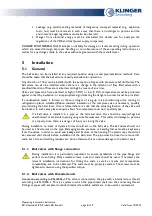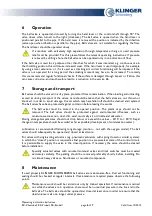
Operating instruction ball valves
RK-Chemoball, RK-Proball, RK-Ecoball
page
5
of
7
Valid from 12/2013
Connection according to EN ISO 228-1: The screw connections have a internal screw thread
according to EN ISO 228-1. This is a system in which the pipe thread does not seal into the connecting
thread. Fittings or pipes with a cylindrical outside thread and a seal are required, for example, as
counterpart. The seal should be inserted between the supporting surface of the flange sleeve and the
flat front surface of the counterpart and then compacted. The sealing surfaces must be metallically
clean and dry. Suitable seals should be used (pay attention to temperature and medium resistance), and
the relevant applicable installation instructions are to be observed.
The housing of the ball valves has an attached hexagon on both sides. This enables the the ball
valve to be held in the required installation position by means of a suitable tool when screwing
in the counterpart, and the screwing forces can be countered.
5.1.3 Ball valves with welded connection
These ball valves are suitable for use with the gas and arc welding processes. Proper sealing can be
guaranteed only if welding has been carried out expertly.
Extended butt weld ends
The construction length is selected in such a way that, with correct execution of the weld the
complete valve can be welded in. The following points must be observed here:
•
Tack weld the ball valve in the pipe with at least 3 welding spots (offset at 120°)
•
Weld together – colour-change crayons are recommended for checking the temperature.
The temperature during preheating and welding should not exceed 200°C in the area at
the edge of the housing. Cooling during the welding operation is advisable.
•
After the weld seam has cooled down the housing screw connections are tightened with
the specified torque (see technical data sheet).
•
Carry out a functional check.
Butt weld ends
•
Tack weld the ball valve in the pipe with at least 3 welding spots (offset at 120°) per
connection.
•
Dismount the ball valve and mount a spacer in its place.
•
Weld the connections completely and allow to cool.
•
Remove the spacer and mount the ball valve. In doing so observe the specified torques for
the housing connecting screws (see technical data sheet).
•
Carry out a functional check.
5.2
Valves with actuators
5.2.1
General instructions
Electrical lines must be connected only by competent persons. The VDE 0100 and VDE 0165
(Explosion Protection) regulations are to be observed. All electrical devices, such as servo
drives, switch boxes, solenoid valves, limit switches etc must be installed in dry areas
protected from flooding. The voltage and frequency must correspond to the data given on the
name plate. If the user fits a self-automation system the mechanical stops must be removed.
5.2.2 Functional testing
The shutting off function should be tested by operating several times. For valves with electrical and
pneumatic drives the regulating distances / forces must be limited. For this the operating instructions of
the drive manufacturer must be followed.

























